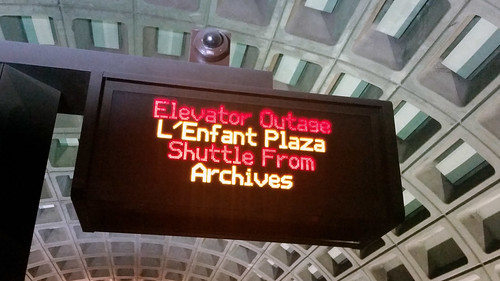By prioritizing elevator information rather than train arrivals on its platform displays, WMATA forces riders to make bad decisions. The result: inefficient use of sparse train capacity.

Not the best use of this technology.
Picture yourself in this scenario
Imagine you’re descending into a Red Line station. You hear a train approaching and rush to the platform. The train pulls up and you see that it’s full.
You glance over at the real-time train arrival display, hoping there will be another train a minute or two behind. If so, you’ll wait for it rather than crowd on now. Maybe you’ll have just enough time to move down the platform to a less crowded spot.
Alas, the display is cycling through elevator outages on the Orange Line in Virginia. Who knows how long until the next train arrives. You’d better crowd on now.
Prioritizing less important info results in badly informed riders
Scenarios like that play out thousands of times every day all over the Metrorail system. It happens because Metro’s PIDs, the Passenger Information Displays that show how long until the next train arrives, are programmed to also cycle through each elevator outage in the entire system.
Cycling through elevator outages often takes a long time, making it difficult for riders to get the real-time train arrival information that the displays were invented to show.
In turn, badly-informed riders can’t use the system efficiently, and exacerbate overcrowding. Without good information, riders push onto full trains when an empty one is a minute behind, and rush into the nearest door rather than move down the platform to a less crowded one.
Those are increasingly important problems given Metro’s capacity limitations.
Wheelchair users need elevator info
WMATA displays elevator outages on the PIDs because it’s crucial information for a small minority of riders: the wheelchair bound, and others who can’t use escalators or stairs.
For those groups, having plenty of advanced notice about which elevators are out is absolutely necessary. Removing that information from stations would therefore be an unacceptable trade-off.
But that information doesn’t have to be on the same screens as train arrival information. In fact, trying to display multiple elevator outages on the PIDs, where there’s only enough room to scroll through them one by one, is a remarkably bad way to provide that information.

A better way, in Chicago. Photo by Matt’ Johnson on Flickr.
Displaying elevator outages on the PIDs requires riders who need that information to wait and watch an entire cycle, even if a train they could take is on the platform now.
It would be far more efficient to display that info on a separate screen that can show several outages at once, like the larger more advanced screens at station manager kiosks.
Or even a low-tech dry erase board, the preferred solution for Chicago’s CTA.
By trying to satisfy two entirely different sets of needs with one limited screen that runs on decades-old technology, WMATA isn’t getting as much out of the PIDs as it could.
 Comment on this at the version cross-posted to Greater Greater Washington.
Comment on this at the version cross-posted to Greater Greater Washington.
July 24th, 2015 | Permalink
Tags: metrorail, transportation













